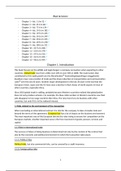Wat te leren:
- Chapter 1 > blz. 1 t/m 32
- Chapter 2 > blz. 35 t/m 68
- Chapter 3 > blz. 75 t/m 134
- Chapter 4 > blz. 141 t/m 182
- Chapter 5 > blz. 197 t/m 235
- Chapter 6 > blz. 241 t/m 249
- Chapter 7 > blz. 253 t/m 255
- Chapter 8 > blz. 259 t/m 278
- Chapter 9 > blz. 285 t/m 311
- Chapter 10 > 317 t/m 328
- Chapter 11 > 335 t/m 378
- Chapter 12 > 391 t/m 416
- Chapter 13 > 421 t/m 456
- Chapter 15 > 481 t/m 494
Chapter 1. Introduction
This book focuses on the pitfalls and legal dangers a company encounters when exporting to other
countries. Global trade rose from a little over 20% to over 50% in 2008. The main factors that
contributed to this rapid growth are the liberalization (1) (toetredingsbeperkingen weggehaald,
daardoor meer concurrentie) of trade and the sharp reduction in transportation and communication
costs(2) over the last 30 years. Another major development in the last 30 years is the fact that the
European Union, Japan and the US have seen a decline in their shares of world exports in favor of
other countries, especially China.
Since 2010 global trade is stalling, probably because Western countries realized that globalization
does not only produce winners. For example, the blue-collar workers in Western countries saw their
jobs disappear to low-wage countries like China. The new trend is to do business with other
countries, but only if it is in the national interest.
1. Risks related to the environment of the transaction
When concluding an international contract it is vital for the company to take a broader look and
beyond the terms of the agreement. European law has a lot of impact on the business environment.
The most important area of the European law are the rules trying to ensure fair competition on the
European markets. Another important area is the free movement of goods, persons, services and
capital.
1.1. Risks in international trade
The success or failure of doing business is determined not only by the content of the contract but
also by the economic and political environment in which the transaction takes place.
1.1.1. Political risks
Political risks, but also commercial risks, can be covered by a credit insurance.
1.1.2. Foreign policy risks
1
, Wars and embargos are examples of foreign policy risks. This makes it impossible to deliver goods or
to get paid. The UN sanctions against Iran and North Korea and the US embargo against Cuba. The
greatest foreign policy risk to individual contracts of sale is restrictions on trade. Especially in an
economic climate where most economies are facing headwinds, politicians try to protect their
national industries by implementing trade restrictions. In particular, emerging economies led by
Argentina, Brazil, India, Indonesia, Russia, China and South Africa continued to apply the highest
number of potentially trade-restrictive measures.
There is a particular increase in the adoption of border measures, which represented more than 40
percent of the new measures. Behind-the-border measures are part of long-term policies aiming at
boosting domestic industries. There are the following categories:
- (1) State aid to national companies > makes it difficult for foreign companies to compete with
their products.
- (2) Competitive devaluation > a country can decide to print more money, this leads to a
depreciation of the currency against others and it makes it cheaper for foreigners to buy
products coming from the devaluating country.
Very dangerous! > can lead to currency wars. Eventually this can lead to
hyperinflation.
- (3) Consumption subsidy > this is bad news for producers of competitive products, these
products become more expensive relative to the subsidized product.
- (4) Export subsidy > if a country subsidizes a product which is exported, competitors in the
importing country is in a disadvantageous position: their prices will probably be higher.
- (5) Export taxes or restriction > reasons: preservation of natural resources; protect national
security; to encourage the supply of raw materials of local industries.
- (6) Import ban > to protect existing domestic industries and reduce the country’s
dependence on imports. Domestic producers can sell their products more easily and at
higher prices. Import bans can also be entered to protect the health of the population or to
protect the environment.
- (7) Investment measures > a legislation which prohibits foreigners from investing in certain
industries or owning certain industries. Another option is to nationalize companies.
- (8) Local content requirement > often established by emerging countries. For example, in
France there is a law which forbids use of the English language in advertisings. This makes it
more difficult for foreign brands to become famous in France.
- (9) Migration measure > governments allowing fewer immigrants into the country, to protect
their own workforce. Massive immigration often causes social problems. A great number of
immigrants send parts of the money they earn to their native country rather than spending it
in the country the migrated to.
- (10) Other service sector measures > it becomes more difficult for foreign banks not aided by
the State to compete with State banks. In the past, native banks were saved by the state with
taxpayers’ money, perhaps some of these rescues were necessary because the bankruptcy of
a large bank could cripple the financial system.
- (11) Public procurement > there are several ways countries try to benefit their own
industries:
‘Buy-local’ campaigns: for example in the State of Maryland (USA), there is a ‘Buy
American’ bill. This bill states that, with certain exemptions, a public city, country or
state, must require a contractor or subcontractor to use or supply American-
manufactured goods in the performance of a contract for:
o Constructing or maintaining a public work; or
2






